Eurocom Monster 1.0: Clevo's Little Monster
by Vivek Gowri on May 18, 2012 4:55 AM EST- Posted in
- Laptops
- Clevo
- Eurocom
- Ivy Bridge
- Kepler
A Powerful 11.6" Laptop
Well, this is the part everyone has been waiting for. I’ll just let the numbers speak for themselves here. The Monster is fast by notebook standards, phenomenally so when compared to other machines in this size class. It’s just an order of magnitude faster than just about anything else in the 11-13” range. The M14x R2 is probably the closest you’re going to get, and that’s a solid two pounds heavier than the Monster.
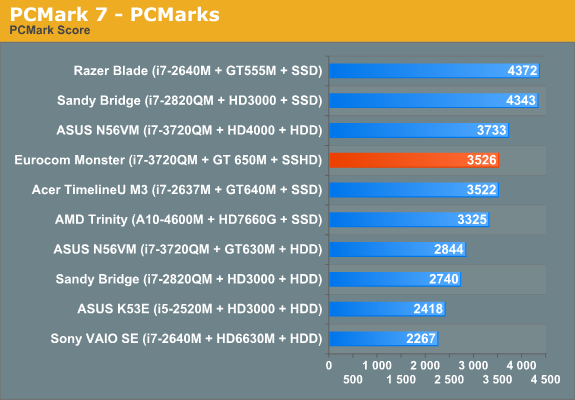
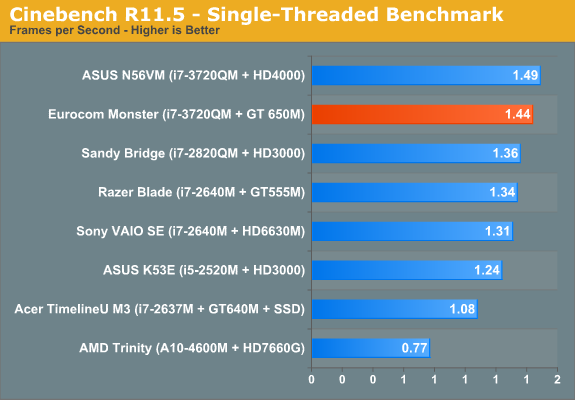
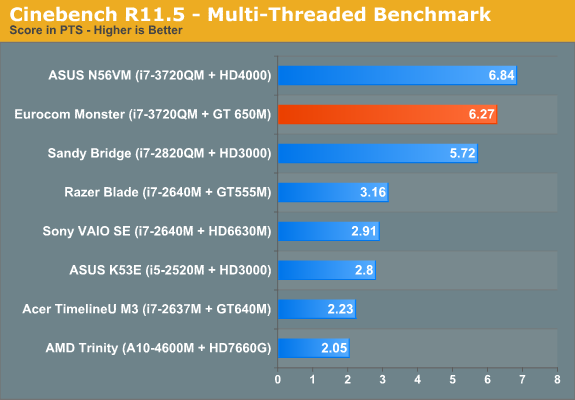
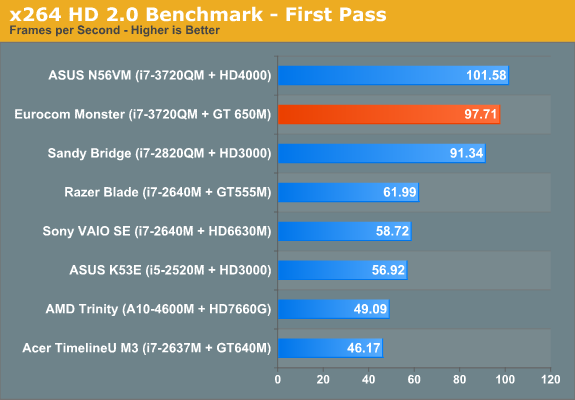

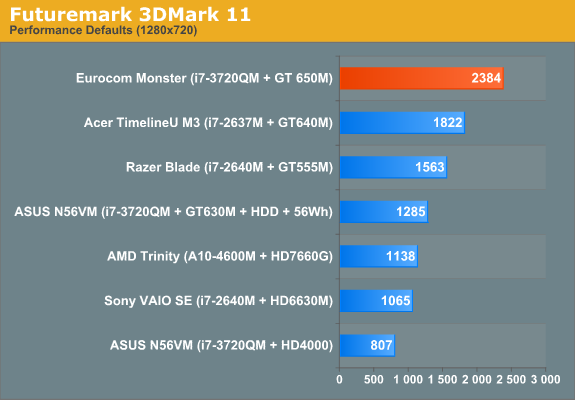
Jarred did a deep dive into the performance of the mobile IVB quad-core chips in the Mobile Ivy Bridge Performance Preview, so you can take a look at more benchmarks and the improvements in Quick Sync and the integrated GPU there. The ASUS N56VM we looked at in that piece had the same i7-3720QM processor as our Monster evaluation unit, so results are very comparable.
IVB is considered a tick+, bringing new lithography along with an architectural overhaul on the GPU side, but the CPU microarchitecture in IVB is pretty similar to SNB. As we noted in the performance preview, raw CPU performance hasn’t really improved that much over SNB, with differences in the 10-20% range. It’s decent, but not life-changing in the same way as the jump from Clarksfield to SNB.
A note on hybrid hard drives—if you’re looking for consistent SSD-like performance, you’re going to be disappointed. Which might sound obvious, but I’m not talking about it in the numbers sense; other than boot times, the Momentus XT just doesn’t feel as consistently responsive as an SSD tends to be. In fact, it doesn’t feel particularly more responsive than a typical 2.5” 7200RPM hard drive. The problem is down to the fact that the NAND cache isn’t predictive, so the first few times you do anything, it feels like a standard 7200RPM drive. Over time, it’ll eventually store the most frequently read data into cache and deliver near-SSD performance for that data, but until that happens, along with any workflows outside of the cached data, the drive will feel agonizingly slow. On a system that has this level of raw compute horsepower, the hybrid drive is a serious bottleneck. You’re better off with any newer SSD, and relying on a USB 3.0 external hard drive if you need extra storage space. With 120GB SF-based drives starting to go lower than the $1/GB mark, there’s no reason not to do it anymore.










47 Comments
View All Comments
Meaker10 - Friday, May 18, 2012 - link
I meant to say the M14X version is GDDR5 as opposed to the clevo DDR3.ptmmac - Friday, May 18, 2012 - link
I would not be at all surprised if Apple went all in on thin and fast notebooks with high resolution screens. How about an 11" notebook with a much higher resolution screen and the 640GT with thunderbolt, USB3 and OSX? The bigger SSD below would leave space for dual boot as well.Does anyone sell something similar to the phone protection layers that changes a screen from shiny to matte? It doesn't seem that hard to do and would really be a lot cheaper and easier then ordering a separate screen for the same SKU. A matte finish is nothing more than a reduction of the reflectivity of the screen.
Another option as far as the SSD is this 240 Gig SSD from new egg.
http://www.newegg.com/Product/Product.aspx?Item=N8...
It is almost exactly 1$ per gigabyte in price and has twice the room.
Roland00Address - Friday, May 18, 2012 - link
The motherboard does not have any slot for a msata hard drive?drfish - Friday, May 18, 2012 - link
Not that I'm doing the exact same test but I have a 3610QM in mine and I get about 3.5 hours doing what I would consider light Internet browsing... Can you share any more details? I'm running with the default "balanced" Windows power profile and a 128GB Samsung 830, 1.35v RAM, Killer 1102. I am using Opera instead of IE though, lol.BTW, the 1103 will be lacking one of its antennas in this system, only two built in.
JarredWalton - Friday, May 18, 2012 - link
We test at 100 nits brightness (I'm not sure what that works out to for this laptop -- Vivek would have to respond for that), and we use the Power Saver setting. We set the HDD to power off after 1 minute of inactivity, disable screen dimming/power off, set WiFi to maximum power saving, and let the CPU run from 0% to 100% depending on requirements, and we mute the audio. We also test using Internet Explorer. For the web browsing, we load four web pages that have some Flash ads and plenty of images; these pages are refreshed every 60 seconds until power is lost.My experience is that the "Balanced" defaults will usually cut battery life by around 10-15%, and most other browsers aren't quite as power optimized as IE, interestingly enough. They're faster but on average things like Flash use more CPU time I guess. But the bigger factory is probably the number of web pages you have open as well as how often you're loading new web pages, and whether you're doing other things besides just web browsing.
Daniel Egger - Friday, May 18, 2012 - link
Killer Wireless but Realtek GigE? What kind of freak combines the (supposedly) best WLAN implementation with the worst Ethernet chipsets on the planet? Not that any half-way serious player would use opt to use WLAN over a cable anyway...JarredWalton - Friday, May 18, 2012 - link
Have you really had that bad of experiences with Realtek's GigE implementations? Because I've been running GigE in my house for roughly a decade, and generally speaking I've had no complaints with the various chipsets. Some might have lower CPU load, but rarely am I transferring a bunch of data while doing some other tasks that I notice. My general impression is that wired Ethernet controllers have become commoditized for most users -- 2% CPU load vs. 10% load on a quad-core + Hyper-Threading system just doesn't affect me, and sustained transfer rates over 100MiB/s is faster than what most HDDs can handle (though SSDs certainly can hit higher speeds).Daniel Egger - Friday, May 18, 2012 - link
Yes. These things produce all kinds of troubles:- Lousy drivers for various (Windows) OSes, especially new ones like 64bit Windows
- Weak hardware (little buffering, little offloading, outdated communication with the host...) means busy hosts will lose packets very easily -> no reliable connections under CPU load
- Bad and stupid PHYs causing all kinds of nasty errors with long cables, bad shielding, corroded contacts...
This is only covering the basic features, don't let me get started on jumbo frames, vlan support, virtualisation and other "Pro"ish topics.
Long story short: If it says Realteak Ethernet that an absolute dealbreaker for me. Unfortunately this crap is *really* common with certain categories of laptops. :/
JarredWalton - Friday, May 18, 2012 - link
Just to be clear, are you running this stuff in a server or workplace or something? The errors you describe don't sound like home use problems, at least. I've never had issues with cable lengths, but then I've never used any cables more than around 100 ft. Heck, most people with laptops don't even use wired cables at all unless it's at work. I do understand that if you were trying to use a bunch of Realtek chipsets in a business environment with a lot of systems on a network, the list starts to matter a lot more.For home use, though, I've never needed to use any of the "Proish" features you list. YMMV, naturally. Still, it's good to know specifically what types of errors people are running into. If I ever get around to testing GbE chipsets, I'll have to delve a little deeper into the nitty gritty stuff -- not realistically, that's not going to happen.
Daniel Egger - Friday, May 18, 2012 - link
> Just to be clear, are you running this stuff in a server or workplace or something?Coincidentally all of them. But actually the quality matters more in not so tightly controlled environments like simple homes.
> The errors you describe don't sound like home use problems, at least.
All of them tend to be huge problems at home when unskilled people try to run a home network which is very common since many devices do not have WLAN at all like NASses, SIP phones and ATAs, printers or often run quite unreliable when connected to WLANs like STBs, television sets, media players...
> Heck, most people with laptops don't even use wired cables at all unless it's at work.
I would not be so sure of that. WLAN is still slow when compared to GigE, unreliable and quite problematic in multi-story brick and mortar or concrete building (even more so with floor heating) and in dense cities. Where I live WLANs are mostly used as slow backup and for mobile phones.
And in fact I rather doubt that any serious gamer (the target group for the Eurocom Monster?!?) will be using WLAN at a party even if it actually was available.
> I do understand that if you were trying to use a bunch of Realtek chipsets in a business environment with a lot of systems on a network, the list starts to matter a lot more.
Rather the opposite. In businesses you typically have high quality calibrated cabling and switches which will adapt cable lengths and and bad client chipsets ... and alert sysadmin when links drop too often or too many packets are lost. It's almost impossible that a Realtek chipset will mess that up. ;)